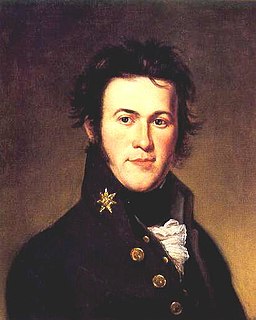
Thomas Say was an American entomologist, conchologist, and herpetologist. His definitive studies of insects and shells, numerous contributions to scientific journals, and scientific expeditions to Florida, Georgia, the Rocky Mountains, Mexico, and elsewhere made him an internationally known naturalist. Say has been called the father of American descriptive entomology and American conchology. He served as librarian for the Academy of Natural Sciences of Philadelphia, curator at the American Philosophical Society, and professor of natural history at the University of Pennsylvania.
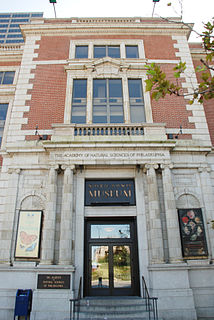
The Academy of Natural Sciences of Drexel University, formerly the Academy of Natural Sciences of Philadelphia, is the oldest natural science research institution and museum in the Americas. It was founded in 1812, by many of the leading naturalists of the young American republic with an expressed mission of "the encouragement and cultivation of the sciences". For over two centuries of continuous operations, the Academy has sponsored expeditions, conducted original environmental and systematics research, and amassed natural history collections containing more than 17 million specimens. The Academy also has a long tradition of public exhibits and educational programs for both schools and the general public.
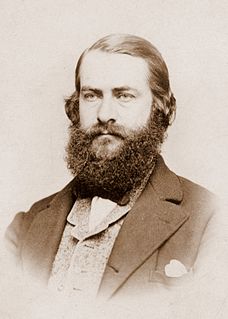
Joseph Mellick Leidy was an American paleontologist, parasitologist, geologist, and anatomist.

The Canyon Diablo meteorites include the many fragments of the asteroid that created Barringer Crater, Arizona, United States. Meteorites have been found around the crater rim, and are named for nearby Canyon Diablo, which lies about three to four miles west of the crater.
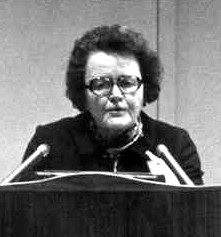
Ruth Myrtle Patrick was an American botanist and limnologist specializing in diatoms and freshwater ecology. She authored more than 200 scientific papers, developed ways to measure the health of freshwater ecosystems and established numerous research facilities.

Lost Maples State Natural Area is a large, pristine area of beautiful hills and canyons on the upper Sabinal River in the Edwards Plateau Region of Texas. It is designated a Natural Area, rather than a State Park, which means the primary focus is the maintenance and protection of the property's natural state. Accordingly, access and recreational activities may be restricted if the Texas Parks & Wildlife Department (TPWD) deems such action necessary to protect the environment.
Driftwood Canyon Provincial Park is a provincial park in British Columbia, Canada. Driftwood Canyon Provincial Park covers 23 ha of the Bulkley River Valley, on the east side of Driftwood Creek, a tributary of the Bulkley River, 10 km northeast of the town of Smithers. The park is accessible from Driftwood Road from Provincial Highway 16. It was created in 1967 by the donation of the land by the late Gordon Harvey (1913–1976) to protect fossil beds on the east side of Driftwood Creek. The beds were discovered around the beginning of the 20th century. The park lands are part of the asserted traditional territory of the Wet'suwet'en First Nation.

Henry Augustus Pilsbry was an American biologist, malacologist and carcinologist, among other areas of study. He was a dominant presence in many fields of invertebrate taxonomy for the better part of a century. For much of his career, his authority with respect to the classification of certain substantial groups of organisms was unchallenged: barnacles, chitons, North American terrestrial mollusks, and others.

The Franklin Mountain woodland snail is a species of land snail in the family Polygyridae. It is native to New Mexico and Texas in the United States.

Ashmunella is a genus of small, air-breathing, land snails in the family Polygyridae.
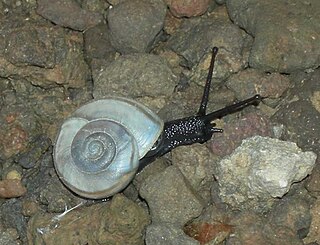
Sonorella is a genus of land snails in the family Helminthoglyptidae. They are known commonly as talussnails or talus snails because most live in talus and similar habitat. They are distributed across the southwestern United States and adjacentMexico. There are about 80 species.
Burnet Cave is an important archaeological and paleontological site located in Eddy County, New Mexico, United States within the Guadalupe Mountains.

Aztlanolagus is an extinct monotypic genus of rabbit that lived during the Quaternary in what is now the Southern to Southwestern United States and northern Mexico. Aztlanolagus agilis is currently the only recognized species, though differences among recovered fossils suggest that there may have been other species. The generic name refers to Aztlán, the legendary place of origin of the Nahua peoples as recorded in the mythological accounts of the Aztecs and other Nahua groups. By some traditions, this legendary locale is placed in the border regions of the Southwestern United States and adjacent northern Mexico.
Conkling Cavern is a paleontological and archaeological site located in Doña Ana County, New Mexico. It was excavated in the late 1920s under the direction of Chester Stock. Unfortunately, Stock never published the fossil fauna from the excavations. Instead, R. P. Conkling, who had drawn scientific attention to the site, published very preliminary lists of mammals identified by Stock and birds identified by Howard. Several authors have done research on portions of the recovered fossil fauna. Excavated before modern dating techniques were developed, little is known about the chronology except some apparently is Holocene and much is Pleistocene in age.
Shelter Cave is an archaeological and paleontological site located in Doña Ana County, New Mexico.
Gary Rosenberg is an American malacologist.

Artie Lou Metcalf was an American malacologist.

Arthur H. Harris is an American mammalogist and paleontologist.
Notiosorex harrisi is an extinct species of shrew from the subfamily Soricinae.
Ashmunella harrisi is a species of air-breathing land snail, a terrestrial pulmonate gastropod mollusk in the family Polygyridae.











